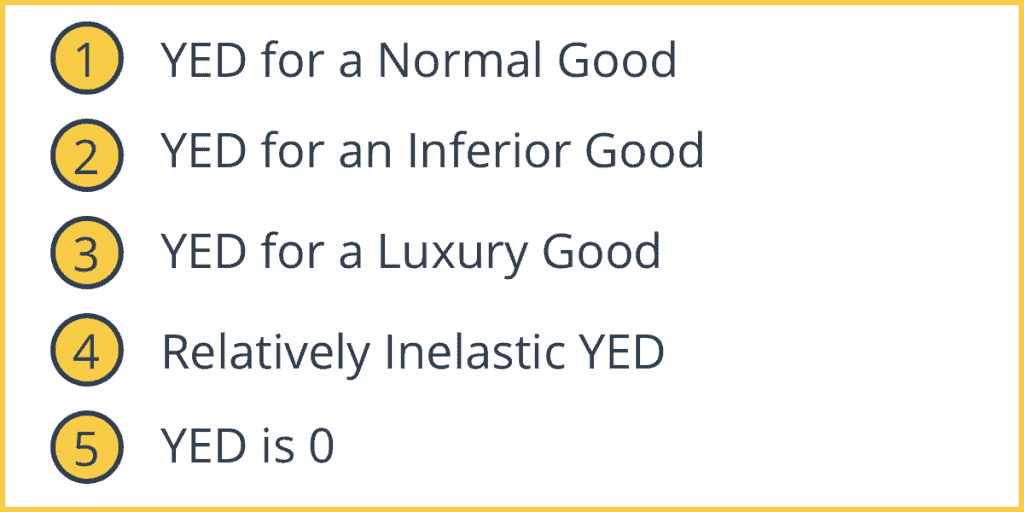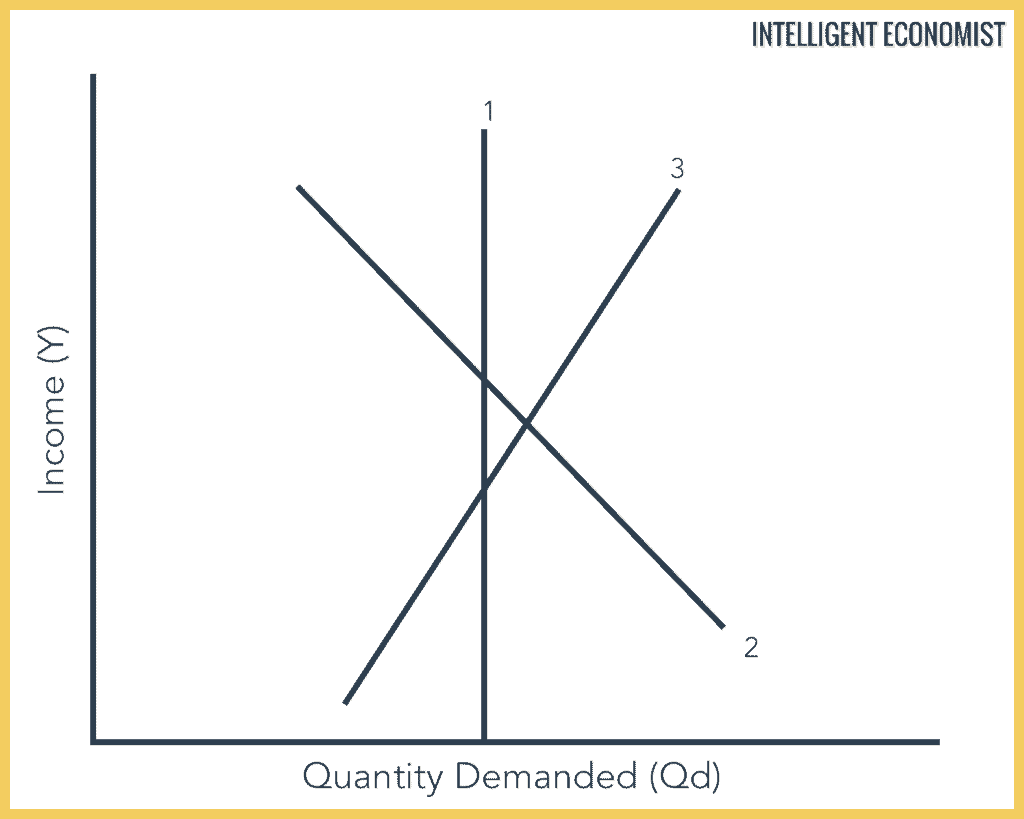Income Elasticity of Demand (YED) is defined as the responsiveness of demand when a consumer’s income changes. It is defined as the ratio of the change in quantity demanded over the change in income.
The higher the income elasticity, the more sensitive demand for a good is to changes in income. This means that a very high-income elasticity of demand suggests that when a consumer’s income goes up, consumers will buy a lot more of that good and, reciprocally, when income goes down consumers will cut back their purchases of that good to an even higher degree. A very low price elasticity implies that changes in a consumer’s income will have little effect on demand.
YED is useful for governments and firms to help them decide what goods to produce and how a change in overall income in the economy affects the demand for their products, i.e., whether it’s inelastic or elastic.
YED can be positive or negative. This depends on the type of good. A normal good has a positive sign, while an inferior good has a negative sign.
For example, if a person experiences a 20% increase in income, the quantity demanded for a good increased by 20%, then the income elasticity of demand would be 20%/20% = 1. This would make it a normal good.
Income Elasticity of Demand Formula
The formula for calculating the Income Elasticity of Demand is defined as the ratio of the change in quantity demand over the change in income.

We can express this as the following:
YED = (New Quantity Demand – Old Quantity Demand)/(Old Quantity Demand) / (New Income – Old Income)/(Old Income)
Types of Income Elasticity of Demand

We can categorize income elasticity of demand into 5 different categories depending on the value.
Normal goods have a positive income elasticity of demand so as consumers’ income increase, there is an increase in quantity demand.
Necessities have an income elasticity of demand of between 0 and +1. For example, a staple like rice or bread could be considered a necessity.
Inferior goods have a negative income elasticity of demand meaning that demand falls as income rises.
1. Income Elasticity of Demand for a Normal Good
A normal good has an Income Elasticity of Demand > 0. This means the demand for a normal good will increase as the consumer’s income increases.
2. Income Elasticity of Demand for an Inferior Good
An inferior good has an Income Elasticity of Demand < 0. This means the demand for an inferior good will decrease as the consumer’s income decreases.
3. Income Elasticity of Demand for a Luxury Good
Luxury goods usually have Income Elasticity of Demand > 1, which means they are income elastic. This implies that consumer demand is more responsive to a change in income. For example, diamonds are a luxury good that is income elastic.
4. Relatively Inelastic Income Elasticity of Demand
0 < Income Elasticity of Demand < 1 are goods that are relatively inelastic. This means that consumer demand rises less proportionately in response to an increase in income.
5. Income Elasticity of Demand is 0
Income Elasticity of Demand = 0 means that the demand for the good isn’t affected by a change in income.
Income Elasticity of Demand Example
Let’s take an example of a shop that sells widgets. They estimate that when the average real income of its customers falls from $60,000 to $40,000, the demand for its widgets falls from 5,000 to 4,000 units sold, with all other things remaining the same.
Using the income elasticity of demand formula,
YED = (New Quantity Demand – Old Quantity Demand)/(Old Quantity Demand) / (New Income – Old Income)/(Old Income)
= (4,000 – 5,000)/(5,000) / (40,000-60,000)/(60,000)
= ~0.67
This produces an elasticity of 0.67, which indicates customers are not particularly sensitive to changes in their income when it comes to buying these widgets. The demand does not fall significantly with a fall in income.
Engel Curve
Engel Curves show how demand curves are sloped in response to changes in income. A goods Engel curve reflects its income elasticity and indicates whether the good is an inferior, normal, or luxury good. Engel’s law which states that the poorer a family is, the larger the budget share it spends on nourishment.
Curve 2 – Inferior Goods
The Engel curve has a negative gradient. That means that since the consumer has more income, they will buy less of the inferior good because they can purchase better products.
Curve 3 – Normal Goods
It has a positive gradient. As income increases, the quantity demanded increases. Amongst normal goods, there are two possibilities. Although the Engel curve remains upward sloping in both cases, it bends toward the Y-axis for necessities (Curve 1) and towards the X-axis for luxury goods.

Uses of Engel Curves
Engel curves are used for equivalence scale calculations and related welfare comparisons, and to determine properties of demand systems such as aggregability and rank.
Engel curves have also been used to study how the changing industrial composition of growing economies are linked to the changes in the composition of household demand.


If you know the YED and the percentage change in QD, how do you calculate what the change in income has been?
The value will come 2 it’s a positive income elastic product! You can understand it as a superior good.
What is the income elasticity of demand when income changes by 20% and demand changes by 40% ?
Yeah what is the solution to that??
“This means the demand for an inferior good will decrease as the consumer’s income decreases.” Wouldn’t demand for an inferior good increase if consumer income decreases?
It has been made so simple
Thanks alot
But with the curves do they explain the slope and how does a curve with a negative gradient look like
Soppose the income of consumer increase from #300 to #400 but his demand for a commodity fall from 15 to 10 unit.